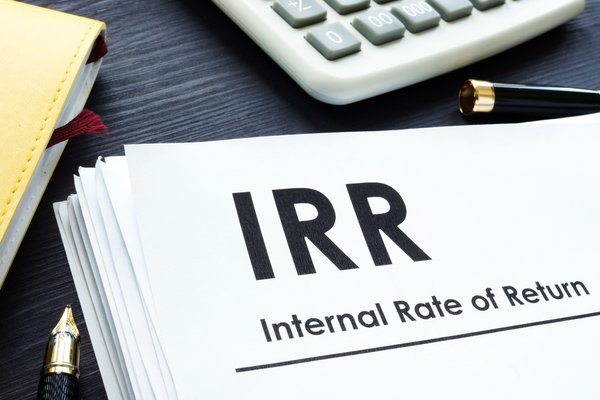There is no shortage of deals and investment opportunities out there. The key is finding the right deal/s that meet your investment criteria and needs. Internal rate of return (or IRR) is a tool investors can use in that decision-making process. What is IRR and how can real estate investors use it to make decisions?

What is IRR?
Put simply, IRR is used to help judge the profitability and return profile of a potential investment. The IRR of a potential investment is the discount rate or rate of return that you’re getting from an investment when you consider the initial cash outlay against the timing and size of future cash flows. Generally speaking, the higher the IRR, the better the investment opportunity (assuming a similar level of risk).
Calculating IRR
The definition of IRR can be a bit tricky to wrap your head around, so it’s best to conceptualize with a few examples. Before getting into the formula to use for a complex calculation, let’s look at a simple example based on comparing two different stocks.
Stock #1: Purchase price today is $100 with an anticipated dividend of $2.50 in a year. You expect that you can sell the stock for $125 two years from today.
Stock #2: Purchase price today is $100 with no anticipated dividend. You expect that you can sell the stock for $127.5 two years from today.
You’ll notice that both stocks have the same initial investment and total cash flow over the same time horizon. Stock #1 has an IRR of 13.06% though, while Stock #2 has an IRR of 12.92%.
Why is that the case? It’s because of the timing of when the cash flows occur. Since you’re receiving cash in the form of a dividend after one year from Stock #1, your rate of return is a bit higher than Stock #2, which sees no cash return for two years. Although basic, this points to a key feature of the IRR calculation compared to other financial metrics: timing of cash flows.
The IRR formula
Here’s the ugly formula we use to calculate IRR if you want to do it by hand (it’s much simpler and common to use Excel or a financial calculator). There are also many IRR calculators out there available like this one.
Let’s think about this formula as it relates to Stock #1. The formula above is basically asking "What is the rate of return on an investment in which I am outlying $100 today, receiving $2.50 in a year and then $125 in two years?"
Written out that looks like this: $100 = $2.5/(1+r) + $125 (1+r)2
When you do the math, r=13.06%.
Comparing to cash-on-cash return
Cash-on-cash return (CoC) is a simple and easy financial metric investors use to look at a potential investment. CoC is simply the cash flow from an investment divided by the initial cash outlay. If we go back to the example of the two stocks, both actually have the same CoC of 127.5%, even though their timings are different.
CoC is an excellent tool to use when the timing of cash flows is steady and consistent, like with a rental property. For example, if you plan on buying and holding a rental property, CoC probably makes more sense to use than IRR, especially because it's so simple. Let’s say you buy a three-family for $1 million, put $200k down, and your annual cash flow from the property is $16,000. Your annual CoC is then 8% ($16,000/$200,000). There’s no need to get out your financial calculator and calculate IRR.
When is a good time to use IRR?
At the end of the day, you're trying to decide if an investment provides a high enough return to be worth spending money and time on. That being the case, for investments with uneven cash flows, depreciating assets, or when you want to see your return based on the real-time held period, IRR is more appropriate to use than CoC.
Let’s use the example of a three-family home in which you can rent one of the units immediately, but have to do some work in the other two before they can produce cash flow. You expect to rent one of those in year two and the other in year three. To keep it simple, let’s assume the following:
- Purchase price of $1,000,000 with 20% and closing costs of $5,000.
- Rental (gross) income in each unit annual of $30,000.
- Total expenses, including debt service of $75,000 ($25,000 per unit).
- Work to be put into the two units (all in the first year) of $100,000 (consider this an up- front cost to keep things simple).
- You expect to sell the property for $1.5 million in four years with $70,000 of the mortgage paid off.
This is a great example of a time when it is probably more appropriate to use IRR since the cash flows are uneven and timing matters. It’s important to note that IRR should be used in comparing projects against one another. If you’re weighing this project against another similar project and the CoC return is similar but one has a higher IRR (with similar level of anticipated risk), you should opt for the project with the higher IRR.
You need to be careful with IRR
IRR is nice because it is a way to consider different projects that have different time horizons and inconsistent or interim cash flows. That said, IRR can be tricky because it assumes that your reinvestment rate of said cash flows remains the same. In our example, the IRR calculation assumes that we can continue to reinvest the $15,000 in year three at 23%. Is it likely that you have another project you can invest the cash in at 23%? Probably not. And if you reinvest the cash flows at a lower rate, the IRR of the project actually comes down.
The bottom line
IRR is one way to measure the return on investment for real estate investments. This financial metric can especially come in handy when comparing the return profile of multiple deals with different cash flow profiles and holding periods. That said, if you have a simple project with steady cash flows, like a basic multifamily project or fix-and-flip, CoC is safe to use.






























